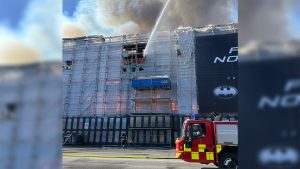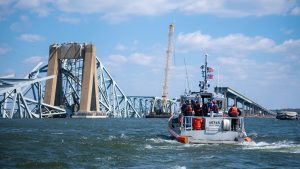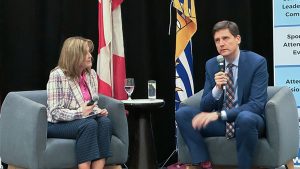The Association of Professional Engineers and Geoscientists of British Columbia (APEGBC) has issued in November 2006 its second set of Bridging Guidelines for earthquake-proofing British Columbia schools, an initiative that has been set forward by the British Columbia government.
School Safety
VANCOUVER
The Association of Professional Engineers and Geoscientists of British Columbia (APEGBC) has issued in November 2006 its second set of Bridging Guidelines for earthquake-proofing British Columbia schools, an initiative that has been set forward by the British Columbia government.
The Bridging Guidelines for the Performance Based Seismic Retrofit of British Columbia School Buildings (Bridging Guidelines) was first issued to complement the 2005 National Building Code and were aimed at addressing schools which were perceived to be high-risk. The second revised set of Bridging Guidelines examines a broader range of structures and provides further solutions to retrofitting structures. While the bridging guidelines have been developed for B.C. schools, it is expected that they can be used for other buildings – such as auditoriums – that have similar problems. Buildings constructed prior to 1970 are assessed at having the greater need for retrofitting. APEGBC chairman Andy Mill, for the committee coordinating the research and development of the guidelines, says it is expected they can be used on low and mid-rise structures “subject to jurisdictional approval but technically they should apply.”
He said the APEGBC committee is currently working on further guidelines for buildings and hopes by the end of the year to remove the word “bridging” from the third set. Work will continue to provide guidelines for schools that need to be retrofitted to make them safe will continue. “We are looking at this as a live document,” he says. It is also anticipated that much of the work in developing the guidelines will be of use to other countries facing the same problem with public schools, which pose an earthquake threat to children.
Attention to the risk posed by collapsing schools has been spearheaded by Vancouver, family physician Dr. Tracy Monk, who became concerned after reading of the 2003 Italian quake that killed 23 students and one teacher. Research found schools in earthquake zones around the world suffered a disproportionate amount of damage in a quake compared to other buildings. The reason was attributed to their construction of rigid materials such as masonry and their use of open spaces for areas such as gymnasiums.
Civil engineer Dr. Carlos Ventura, a leading researcher in earthquake testing at the University of B.C., says early engineers designing schools did not ignore the threat of earthquakes. But, they were working with a less than perfect knowledge base. Today, that knowledge has deepened to include where earthquakes are likely to occur and how to stabilize buildings to prevent loss of life in these quake zones.
Evidence is Canada’s 2005 National Building Code with its upgraded seismic standards for public structures such as schools. But, it only relates to new construction. B.C. has a legacy spanning a century of existing schools, with many falling woefully short of today’s standards.
Monk research also found that an earlier report done in the 1990s maintained that older B.C. schools were 100 times more at risk than the average wood frame housing in a quake. Despite the knowledge having been known for more than a decade, little had been done. Monk began talking to engineers in Canada, the U.S. and “around the world”. Many acknowledged a “crisis of conscience” in knowing that schools were not safe, but they lacked the political voice to effect changes.
Monk’s outspokenness garnered support and she became co-founder of the Families for School Seismic Safety (FSSS) in B.C. FSSS became a major force as Monk has been relentless, talking to politicians, associations, and media. A year later, the 2004 Indian Ocean Tsunami devastation drove Monk’s message home. She found herself before the United Nations in 2005 calling for safe schools internationally. (In June 2007, she will be a keynote speaker at the 9th Canadian Conference on Earthquake Engineering to be held in Ottawa.)
In 2004, two B.C. engineers became involved. UBC.’s Dr. Ventura and APEGBC’s Mill “spent many hours talking to me about the issue of school safety,” says Monk. APEGBC added its support and knowledge to FSSS’s lobbying force giving it informed clout. The task was a large one as schools had a range of building materials, used different construction methods, were situated in different risk zones and on different soil types. Schools built prior to 1970 were generally considered higher risk. There was no simple quick fix. Information had to be gathered but in a uniform way.
FSSS persistence caused the B.C. government’s ministry of education to set aside $1.5 billion to upgrading B.C. schools over a 15-year period. The first step was a $2 million seismic assessment that would look at 800 B.C. schools. The assessment was done with a new tool, a multi-page checklist (examining site, materials and construction methods) which was developed with partner groups including UBC’s civil engineering department and APEGBC. The tool – known as UBC-100 – could assist school board engineers within 39 districts to collect information to be used in determining structural risk. The survey results found 700 schools requiring some level of upgrading.
The second phase was directed at finding ways to bring these structures up to standard. B.C. provided $185,000 to APEGBC through UBC’s engineering department to co-ordinate research on seismic upgrades and deliver a training program to engineers. In order to facilitate the work required to develop the assessment tool and provide Bridging Guidelines that could start the retrofitting process, Mill’s task force formed the seismic peer review committee made up of structural engineers in B.C. and California engineers. The peer committee works closely with Dr. Ventura, who is also the director of UBC’s earthquake engineer research facility, which is one of a few in North America. The facility has the ability to simulate the impact of earthquake damage on structures.
“We are collaborating with APEGBC and the role that we play is taking responsibility for developing the technical components for the retrofits of the schools,” says Dr. Ventura, who also uses an independent peer review committee to review his findings.
The first B.C. schools will see retrofit construction begin in summer of 2007 as the work by APEGBC and the UBC civil engineering department is translated into hammer and nails. But, a huge task looms. Les King, director of facilities for the Vancouver School Board, says Vancouver alone has 109 schools – 101 require retrofits ranging from major to minor.










Recent Comments
comments for this post are closed